Terrestrial Water Storage Component Changes Derived from Multisource Data and Their Responses to ENSO in Nicaragua
Abstract
1. Introduction
2. Study Area and Data Acquisition
2.1. Study Area
2.2. GRACE/GRACE-FO Data
2.3. Hydrological Model and Satellite Altimetry
2.4. Climate Data and Climate Index
3. Methods
3.1. TWS Changes Estimation
3.2. Time Series Analysis
3.3. Workflow
4. Results
4.1. TWSC Changes in Nicaragua
4.2. TWSC Changes in Nicaragua Sub-Basins
4.3. Relationship between TWSC and ENSO
4.3.1. Cross-Correlation Analysis between Interannual TWSC and ENSO
4.3.2. Cross-Wavelet Analysis between TWSC and ENSO
5. Conclusions
Author Contributions
Funding
Data Availability Statement
Conflicts of Interest
References
- Rudolph, J.D. Nicaragua, A Country Study, 2nd ed.; Foreign Area Studies, the American University: Washington, DC, USA, 1982. [Google Scholar]
- Food and Agriculture Organization of the United Nations. Available online: https://www.fao.org/faostat/zh/#data/R (accessed on 21 September 2022).
- Howells, M.; Hermann, S.; Welsch, M.; Bazilian, M.; Segerstrom, R.; Alfstad, T.; Gielen, D.; Rogner, H.; Fischer, G.; van Velthuizen, H.; et al. Integrated analysis of climate change, land-use, energy and water strategies. Nat. Clim. Change 2013, 3, 621–626. [Google Scholar] [CrossRef]
- D’Odorico, P.; Davis, K.F.; Rosa, L.; Carr, J.A.; Chiarelli, D.; Dell’Angelo, J.; Gephart, J.; MacDonald, G.K.; Seekell, D.A.; Suweis, S.; et al. The Global Food-Energy-Water Nexus. Rev. Geophys. 2018, 56, 456–531. [Google Scholar] [CrossRef]
- Ramillien, G.; Frappart, F.; Cazenave, A.; Guntner, A. Time variations of land water storage from an inversion of 2 years of GRACE geoids. Earth Planet. Sci. Lett. 2005, 235, 283–301. [Google Scholar] [CrossRef]
- Cazenave, A.; Nerem, R.S. Geophysics: Redistributing Earth’s mass. Science 2002, 297, 783–784. [Google Scholar] [CrossRef] [PubMed]
- Cox, C.M.; Chao, B.F. Detection of a large-scale mass redistribution in the terrestrial system since 1998. Science 2002, 297, 831–833. [Google Scholar] [CrossRef]
- Chen, J.; Famiglietti, J.S.; Scanlon, B.R.; Rodell, M. Groundwater Storage Changes: Present Status from GRACE Observations. Surv. Geophys 2016, 37, 397–417. [Google Scholar] [CrossRef]
- Chen, Z.W.; Zhang, X.F.; Chen, J.H. Monitoring Terrestrial Water Storage Changes with the Tongji-Grace2018 Model in the Nine Major River Basins of the Chinese Mainland. Remote Sens. 2021, 13, 1851. [Google Scholar] [CrossRef]
- Tapley, B.D.; Bettadpur, S.; Cheng, M.; Hudson, D.; Kruizinga, G. Early Results from the Gravity Recovery And Climate Experiment. In Proceedings of the AIAA/AAS Astrodynamics Specialist Conference, Big Sky, MT, USA, 3–7 August 2003. [Google Scholar]
- Li, P.; Zha, Y.; Shi, L.; Zhong, H.; Tso, C.-H.M.; Wu, M. Assessing the Global Relationships Between Teleconnection Factors and Terrestrial Water Storage Components. Water Resour. Manag. 2022, 36, 119–133. [Google Scholar] [CrossRef]
- Wahr, J.; Molenaar, M.; Bryan, F. Time variability of the Earth’s gravity field: Hydrological and oceanic effects and their possible detection using GRACE. J. Geophys. Res. Solid Earth 1998, 103, 30205–30229. [Google Scholar] [CrossRef]
- Alsdorf, D.; Han, S.-C.; Bates, P.; Melack, J. Seasonal water storage on the Amazon floodplain measured from satellites. Remote Sens. Environ. 2010, 114, 2448–2456. [Google Scholar] [CrossRef]
- Chen, J.L.; Wilson, C.R.; Tapley, B.D.; Yang, Z.L.; Niu, G.Y. 2005 drought event in the Amazon River basin as measured by GRACE and estimated by climate models. J. Geophys. Res.-Solid Earth 2009, 114, B05404. [Google Scholar] [CrossRef]
- Long, D.; Shen, Y.; Sun, A.; Hong, Y.; Longuevergne, L.; Yang, Y.; Li, B.; Chen, L. Drought and flood monitoring for a large karst plateau in Southwest China using extended GRACE data. Remote Sens. Environ. 2014, 155, 145–160. [Google Scholar] [CrossRef]
- Kolusu, S.R.; Shamsudduha, M.; Todd, M.C.; Taylor, R.G.; Seddon, D.; Kashaigili, J.J.; Ebrahim, G.Y.; Cuthbert, M.O.; Sorensen, J.P.R.; Villholth, K.G.; et al. The El Nino event of 2015-2016: Climate anomalies and their impact on groundwater resources in East and Southern Africa. Hydrol. Earth Syst. Sci. 2019, 23, 1751–1762. [Google Scholar] [CrossRef]
- Chen, J.L.; Wilson, C.R.; Tapley, B.D. Satellite gravity measurements confirm accelerated melting of Greenland ice sheet. Science 2006, 313, 1958–1960. [Google Scholar] [CrossRef]
- Rayner, N.A.; Parker, D.E.; Horton, E.B.; Folland, C.K.; Alexander, L.V.; Rowell, D.P.; Kent, E.C.; Kaplan, A. Global analyses of sea surface temperature, sea ice, and night marine air temperature since the late nineteenth century. J. Geophys. Res.-Atmos. 2003, 108, 4407–4428. [Google Scholar] [CrossRef]
- Phillips, T.; Nerem, R.S.; Fox-Kemper, B.; Famiglietti, J.S.; Rajagopalan, B. The influence of ENSO on global terrestrial water storage using GRACE. Geophys. Res. Lett. 2012, 39. [Google Scholar] [CrossRef]
- Ni, S.; Chen, J.; Wilson, C.R.; Li, J.; Hu, X.; Fu, R. Global Terrestrial Water Storage Changes and Connections to ENSO Events. Surv. Geophys 2018, 39, 1–22. [Google Scholar] [CrossRef]
- Bouroncle, C.; Imbach, P.; Rodríguez-Sánchez, B.; Medellín, C.; Martinez-Valle, A.; Läderach, P. Mapping climate change adaptive capacity and vulnerability of smallholder agricultural livelihoods in Central America: Ranking and descriptive approaches to support adaptation strategies. Clim. Change 2017, 141, 123–137. [Google Scholar] [CrossRef]
- Amador, J.A.; Duran-Quesada, A.M.; Rivera, E.R.; Mora, G.; Saenz, F.; Calderon, B.; Mora, N. The easternmost tropical Pacific. Part II: Seasonal and intraseasonal modes of atmospheric variability. Rev. Biol. Trop. 2016, 64, S23–S57. [Google Scholar] [CrossRef]
- Amador, J.A.; Rivera, E.R.; Duran-Quesada, A.M.; Mora, G.; Saenz, F.; Calderon, B.; Mora, N. The easternmost tropical Pacific. Part I: A climate review. Rev. Biol. Trop. 2016, 64, S1–S22. [Google Scholar] [CrossRef]
- Bell, G.D.; Halpert, M.S.; Ropelewski, C.F.; Kousky, V.E.; Douglas, A.V.; Schnell, R.C.; Gelman, M.E. Climate assessment for 1998. Bull. Amer. Meteorol. Soc. 1999, 80, S1–S48. [Google Scholar] [CrossRef]
- Amador, J.A. The Intra-Americas Sea Low-level Jet Overview and Future Research. In Trends and Directions in Climate Research; Gimeno, L., GarciaHerrera, R., Trigo, R.M., Eds.; Annals of the New York Academy of Sciences: San Lorenzo de El Escorial, Spain, 2008; Volume 1146, pp. 153–188. [Google Scholar]
- Munoz-Jimenez, R.; Giraldo-Osorio, J.D.; Brenes-Torres, A.; Avendano-Flores, I.; Nauditt, A.; Hidalgo-Leon, H.G.; Birkel, C. Spatial and temporal patterns, trends and teleconnection of cumulative rainfall deficits across Central America. Int. J. Climatol. 2019, 39, 1940–1953. [Google Scholar] [CrossRef]
- Othman, A.; Abdelrady, A.; Mohamed, A. Monitoring Mass Variations in Iraq Using Time-Variable Gravity Data. Remote Sens. 2022, 14, 3346. [Google Scholar] [CrossRef]
- Richey, A.S.; Thomas, B.F.; Lo, M.-H.; Reager, J.T.; Famiglietti, J.S.; Voss, K.; Swenson, S.; Rodell, M. Quantifying renewable groundwater stress with GRACE. Water Resour. Res. 2015, 51, 5217–5238. [Google Scholar] [CrossRef]
- Beck, H.E.; Zimmermann, N.E.; McVicar, T.R.; Vergopolan, N.; Berg, A.; Wood, E.F. Present and future Koppen-Geiger climate classification maps at 1-km resolution. Sci. Data 2018, 5, 180214. [Google Scholar] [CrossRef]
- Perez-Brignoli, H. A Brief History of Central America, 1st ed.; University of California Press: Berkeley, CA, USA; Los Angeles, CA, USA, 1989. [Google Scholar]
- Serafin, S.; Adler, B.; Cuxart, J.; De Wekker, S.F.J.; Gohm, A.; Grisogono, B.; Kalthoff, N.; Kirshbaum, D.J.; Rotach, M.W.; Schmidli, J.; et al. Exchange Processes in the Atmospheric Boundary Layer Over Mountainous Terrain. Atmosphere 2018, 9, 102. [Google Scholar] [CrossRef]
- Sanchez-Murillo, R.; Esquivel-Hernandez, G.; Corrales-Salazar, J.L.; Castro-Chacon, L.; Duran-Quesada, A.M.; Guerrero-Hernandez, M.; Delgado, V.; Barberena, J.; Montenegro-Rayo, K.; Calderon, H.; et al. Tracer hydrology of the data-scarce and heterogeneous Central American Isthmus. Hydrol Process 2020, 34, 2660–2675. [Google Scholar] [CrossRef]
- Plunkett, H. Nicaragua in Focus: A Guide to the People, Politics and Culture, 1st ed.; Latin American Bureau: Clun, UK, 1999. [Google Scholar]
- Zhao, Z.J.; Han, M.; Yang, K.; Holbrook, N.J. Signatures of midsummer droughts over Central America and Mexico. Clim. Dynam. 2022. [Google Scholar] [CrossRef]
- Chen, Q.; Shen, Y.; Chen, W.; Francis, O.; Zhang, X.; Chen, Q.; Li, W.; Chen, T. An Optimized Short-Arc Approach: Methodology and Application to Develop Refined Time Series of Tongji-Grace2018 GRACE Monthly Solutions. J. Geophys. Res. Solid Earth 2019, 124, 6010–6038. [Google Scholar] [CrossRef]
- Kvas, A.; Behzadpour, S.; Ellmer, M.; Klinger, B.; Strasser, S.; Zehentner, N.; Mayer-Guerr, T. ITSG-Grace2018: Overview and Evaluation of a New GRACE-Only Gravity Field Time Series. J. Geophys. Res. Solid Earth 2019, 124, 9332–9344. [Google Scholar] [CrossRef]
- Swenson, S.; Chambers, D.; Wahr, J. Estimating geocenter variations from a combination of GRACE and ocean model output. J. Geophys. Res.-Solid Earth 2008, 113, B08410. [Google Scholar] [CrossRef]
- Loomis, B.D.; Rachlin, K.E.; Wiese, D.N.; Landerer, F.W.; Luthcke, S.B. Replacing GRACE/GRACE-FO C-30 With Satellite Laser Ranging: Impacts on Antarctic Ice Sheet Mass Change. Geophys. Res. Lett. 2020, 47, e2019GL085488. [Google Scholar] [CrossRef]
- Cheng, M.; Tapley, B.D.; Ries, J.C. Deceleration in the Earth’s oblateness. J. Geophys. Res. Solid Earth 2013, 118, 740–747. [Google Scholar] [CrossRef]
- Jin, S.; Zou, F. Re-estimation of glacier mass loss in Greenland from GRACE with correction of land-ocean leakage effects. Glob. Planet. Change 2015, 135, 170–178. [Google Scholar] [CrossRef]
- Peltier, W.R.; Argus, D.F.; Drummond, R. Comment on “An Assessment of the ICE-6G_C (VM5a) Glacial Isostatic Adjustment Model“ by Purcell et al. J. Geophys. Res.-Solid Earth 2018, 123, 2019–2028. [Google Scholar] [CrossRef]
- Save, H.; Bettadpur, S.; Tapley, B.D. High-resolution CSR GRACE RL05 mascons. J. Geophys. Res. Solid Earth 2016, 121, 7547–7569. [Google Scholar] [CrossRef]
- Li, J.; Chen, J.; Li, Z.; Wang, S.-Y.; Hu, X. Ellipsoidal Correction in GRACE Surface Mass Change Estimation. J. Geophys. Res.-Solid Earth 2017, 122, 9437–9460. [Google Scholar] [CrossRef]
- Rodell, M.; Houser, P.; Jambor, U.; Gottschalck, J.; Mitchell, K.; Meng, C.-J.; Arsenault, K.; Cosgrove, B.; Radakovich, J.; Bosilovich, M. The global land data assimilation system. Bull. Amer. Meteorol. Soc. 2004, 85, 381–394. [Google Scholar] [CrossRef]
- Syed, T.H.; Famiglietti, J.S.; Rodell, M.; Chen, J.; Wilson, C.R. Analysis of terrestrial water storage changes from GRACE and GLDAS. Water Resour. Res. 2008, 44, W02433. [Google Scholar] [CrossRef]
- Landerer, F.W.; Swenson, S.C. Accuracy of scaled GRACE terrestrial water storage estimates. Water Resour. Res. 2012, 48. [Google Scholar] [CrossRef]
- Lenczuk, A.; Weigelt, M.; Kosek, W.; Mikocki, J. Autoregressive Reconstruction of Total Water Storage within GRACE and GRACE Follow-On Gap Period. Energies 2022, 15, 4827. [Google Scholar] [CrossRef]
- Schwatke, C.; Dettmering, D.; Bosch, W.; Seitz, F. DAHITI—An innovative approach for estimating water level time series over inland waters using multi-mission satellite altimetry. Hydrol. Earth Syst. Sci. 2015, 19, 4345–4364. [Google Scholar] [CrossRef]
- Li, W.; Wang, W.; Zhang, C.; Wen, H.; Zhong, Y.; Zhu, Y.; Li, Z. Bridging Terrestrial Water Storage Anomaly During GRACE/GRACE-FO Gap Using SSA Method: A Case Study in China. Sensors 2019, 19, 4144. [Google Scholar] [CrossRef] [PubMed]
- Olauson, J. ERA5: The new champion of wind power modelling? Renew. Energy 2018, 126, 322–331. [Google Scholar] [CrossRef]
- Munoz-Sabater, J.; Dutra, E.; Agusti-Panareda, A.; Albergel, C.; Arduini, G.; Balsamo, G.; Boussetta, S.; Choulga, M.; Harrigan, S.; Hersbach, H.; et al. ERA5-Land: A state-of-the-art global reanalysis dataset for land applications. Earth Syst. Sci. Data 2021, 13, 4349–4383. [Google Scholar] [CrossRef]
- Trenberth, K.E. The definition of EL Nino. Bull. Amer. Meteorol. Soc. 1997, 78, 2771–2778. [Google Scholar] [CrossRef]
- Fenoglio-Marc, L.; Kusche, J.; Becker, M. Mass variation in the Mediterranean Sea from GRACE and its validation by altimetry, steric and hydrologic fields. Geophys. Res. Lett. 2006, 33, 19. [Google Scholar] [CrossRef]
- Zhou, H.; Dai, M.; Wang, P.; Wei, M.; Tang, L.; Xu, S.; Luo, Z. Assessment of GRACE/GRACE Follow-On Terrestrial Water Storage Estimates Using an Improved Forward Modeling Method: A Case Study in Africa. Front. Earth Sci. 2022, 9, 796723. [Google Scholar] [CrossRef]
- Cui, L.; Zhang, C.; Yao, C.; Luo, Z.; Wang, X.; Li, Q. Analysis of the Influencing Factors of Drought Events Based on GRACE Data under Different Climatic Conditions: A Case Study in Mainland China. Water 2021, 13, 2575. [Google Scholar] [CrossRef]
- Chen, W.; Zhong, M.; Feng, W.; Zhong, Y.; Xu, H. Effects of two strong ENSO events on terrestrial water storage anomalies in China from GRACE during 2005-2017. Chinese J. Geophys. Chin. Ed 2020, 63, 141–154. [Google Scholar]
- Zou, F.; Tenzer, R.; Fok, H.S.; Nichol, J.E. Recent Climate Change Feedbacks to Greenland Ice Sheet Mass Changes from GRACE. Remote Sens. 2020, 12, 3250. [Google Scholar] [CrossRef]
- Zhang, Z.; Chao, B.F.; Chen, J.; Wilson, C.R. Terrestrial water storage anomalies of Yangtze River Basin droughts observed by GRACE and connections with ENSO. Glob. Planet. Change 2015, 126, 35–45. [Google Scholar] [CrossRef]
- Grinsted, A.; Moore, J.C.; Jevrejeva, S. Application of the cross wavelet transform and wavelet coherence to geophysical time series. Nonlinear Process. Geophys. 2004, 11, 561–566. [Google Scholar] [CrossRef]
- Cooper, G.R.J.; Cowan, D.R. Comparing time series using wavelet-based semblance analysis. Comput. Geosci. 2008, 34, 95–102. [Google Scholar] [CrossRef]
- Crowley, J.W.; Mitrovica, J.X.; Bailey, R.C.; Tamisiea, M.E.; Davis, J.L. Annual variations in water storage and precipitation in the Amazon Basin. J. Geodesy 2008, 82, 9–13. [Google Scholar] [CrossRef]
- Herrera, D.; Ault, T. Insights from a New High-Resolution Drought Atlas for the Caribbean Spanning 1950-2016. J. Clim. 2017, 30, 7801–7825. [Google Scholar] [CrossRef]
- Ni, S.; Chen, J.; Wilson, C.R.; Hu, X. Long-Term Water Storage Changes of Lake Volta from GRACE and Satellite Altimetry and Connections with Regional Climate. Remote Sens. 2017, 9, 842. [Google Scholar] [CrossRef]
- Chen, J.L.; Wilson, C.R.; Tapley, B.D.; Scanlon, B.; Guntner, A. Long-term groundwater storage change in Victoria, Australia from satellite gravity and in situ observations. Glob. Planet. Change 2016, 139, 56–65. [Google Scholar] [CrossRef]
- Wang, W.; Lee, X.; Xiao, W.; Liu, S.; Schultz, N.; Wang, Y.; Zhang, M.; Zhao, L. Global lake evaporation accelerated by changes in surface energy allocation in a warmer climate. Nat. Geosci. 2018, 11, 410–414. [Google Scholar] [CrossRef]
- Hidalgo, H.G.; Alfaro, E.J.; Quesada-Montano, B. Observed (1970–1999) climate variability in Central America using a high-resolution meteorological dataset with implication to climate change studies. Clim. Change 2017, 141, 13–28. [Google Scholar] [CrossRef]
- Hidalgo, H.G.; Duran-Quesada, A.M.; Amador, J.A.; Alfaro, E.J. The Caribbean Low-Level Jet, the Inter-Tropical Convergence Zone and Precipitation Patterns in the Intra-Americas Sea: A Proposed Dynamical Mechanism. Geogr. Ann. Ser. A Phys. Geogr. 2015, 97, 41–59. [Google Scholar] [CrossRef]
- Kowal, K.M.; Slater, L.J.; Van Loon, A.F.; Birkel, C. SEAS5 skilfully predicts late wet-season precipitation in Central American Dry Corridor excelling in Costa Rica and Nicaragua. Int. J. Climatol. 2022, 42, 4953–4971. [Google Scholar] [CrossRef]
- Yao, C.L.; Luo, Z.C.; Wang, H.H.; Li, Q.; Zhou, H. GRACE-Derived Terrestrial Water Storage Changes in the Inter-Basin Region and Its Possible Influencing Factors: A Case Study of the Sichuan Basin, China. Remote Sens. 2016, 8, 444. [Google Scholar] [CrossRef]
- Joshi, N.; Kalra, A. Analyzing the Association between ENSO and Groundwater Rise in the South Atlantic-Gulf Region in the Southeastern United States. Hydrology 2021, 8, 119. [Google Scholar] [CrossRef]
- Zhang, W.; Li, S.; Jin, F.-F.; Xie, R.; Liu, C.; Stuecker, M.F.; Xue, A. ENSO Regime Changes Responsible for Decadal Phase Relationship Variations Between ENSO Sea Surface Temperature and Warm Water Volume. Geophys. Res. Lett. 2019, 46, 7546–7553. [Google Scholar] [CrossRef]
- Cai, W.; Santoso, A.; Collins, M.; Dewitte, B.; Karamperidou, C.; Kug, J.-S.; Lengaigne, M.; McPhaden, M.J.; Stuecker, M.F.; Taschetto, A.S.; et al. Changing El Nino-Southern Oscillation in a warming climate. Nat. Rev. Earth Environ. 2021, 2, 628–644. [Google Scholar] [CrossRef]
- Geng, T.; Cai, W.; Wu, L.; Santoso, A.; Wang, G.; Jing, Z.; Gan, B.; Yang, Y.; Li, S.; Wang, S.; et al. Emergence of changing Central-Pacific and Eastern-Pacific El Nino-Southern Oscillation in a warming climate. Nat. Commun 2022, 13, 6616. [Google Scholar] [CrossRef] [PubMed]
- Hu, C.D.; Zhang, C.Y.; Yang, S.; Chen, D.K.; He, S.P. Perspective on the northwestward shift of autumn tropical cyclogenesis locations over the western North Pacificfrom shifting ENSO. Clim. Dynam 2018, 51, 2455–2465. [Google Scholar] [CrossRef]
- Pu, L.; Fan, D.; You, W.; Jiang, Z.; Yang, X.; Wan, X.; Nigatu, Z.M. Analysis of mass flux variations in the southern Tibetan Plateau based on an improved spatial domain filtering approach for GRACE/GRACE-FO solutions. Int. J. Remote Sens 2022, 43, 3563–3591. [Google Scholar] [CrossRef]
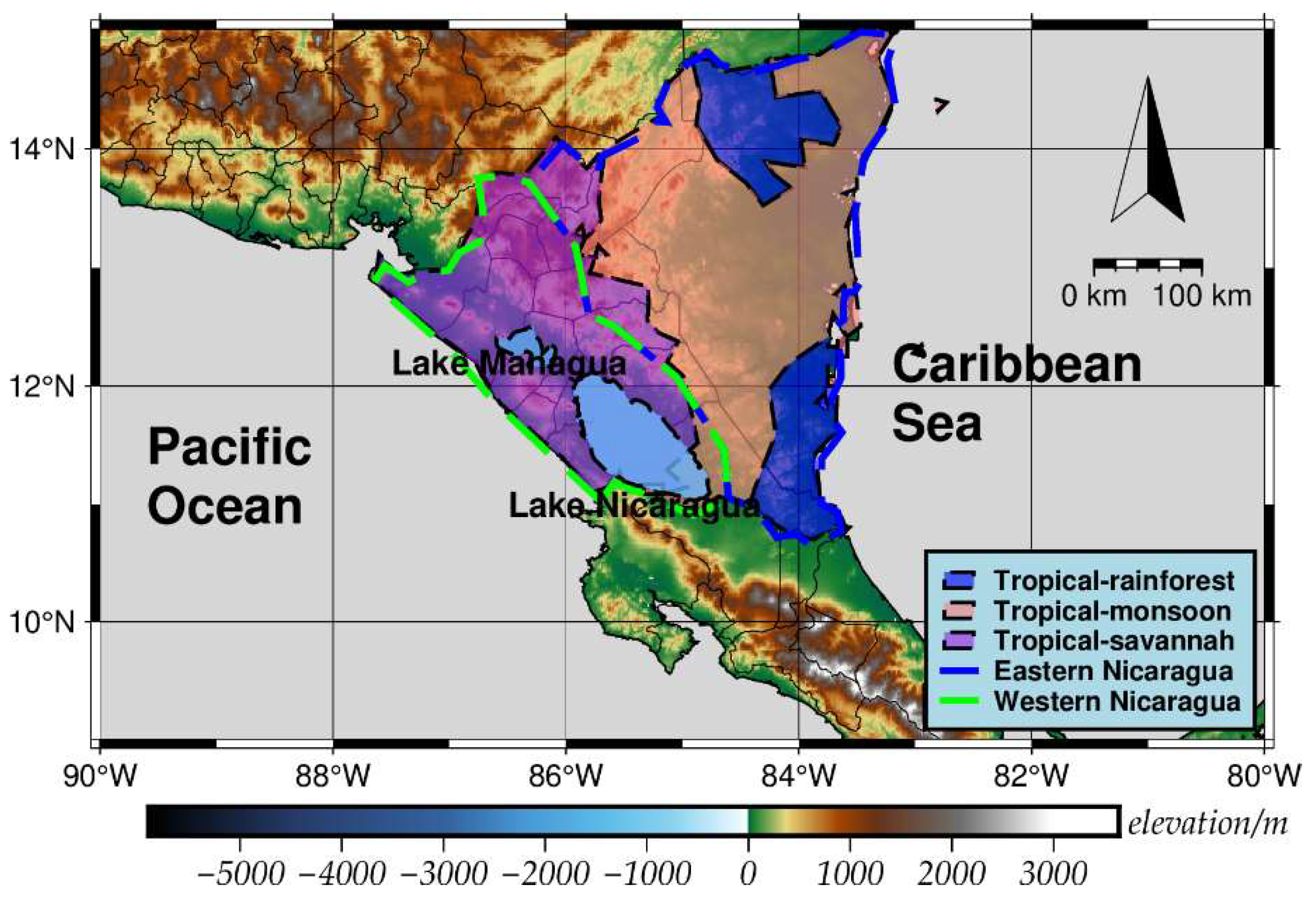


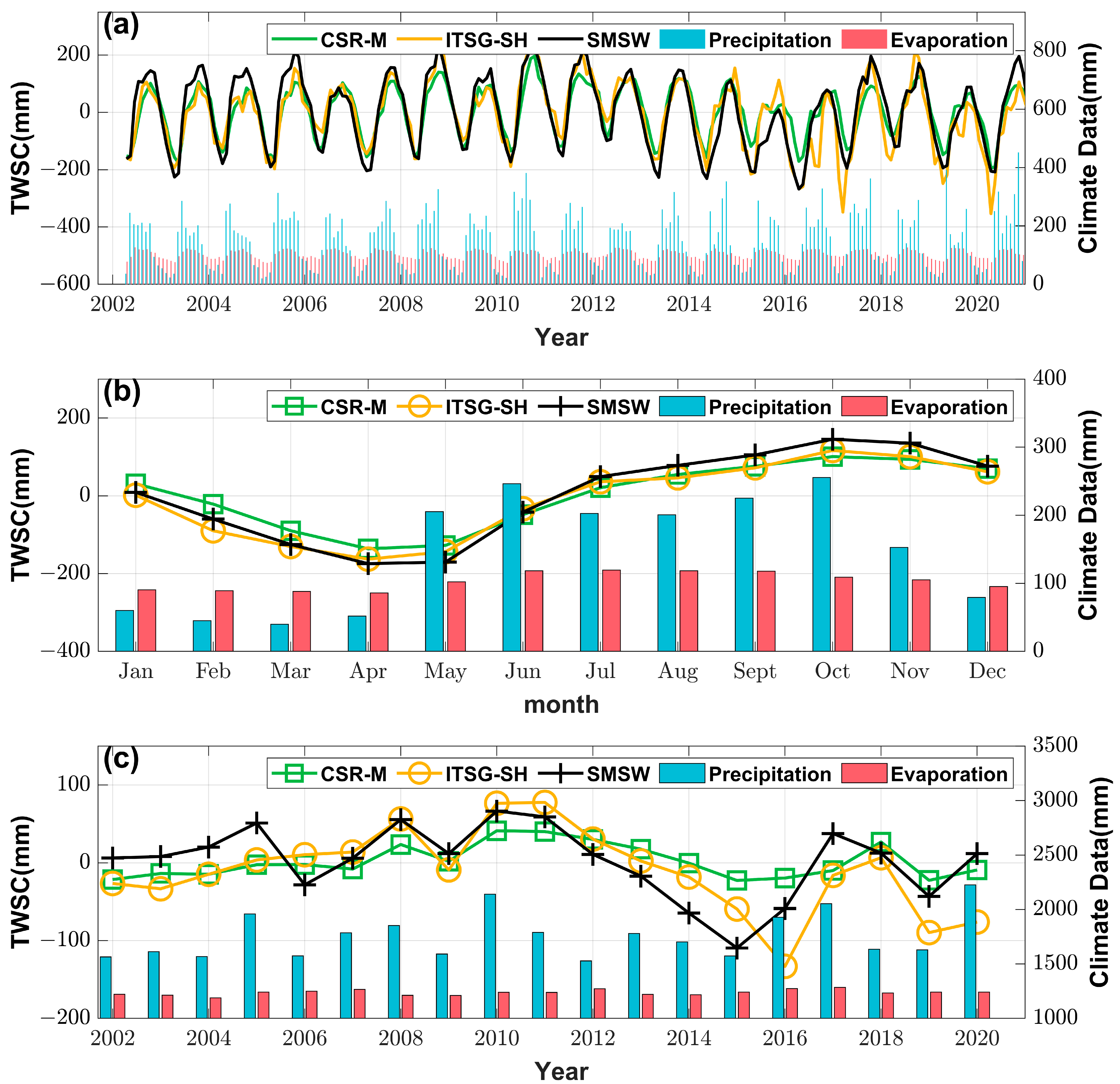
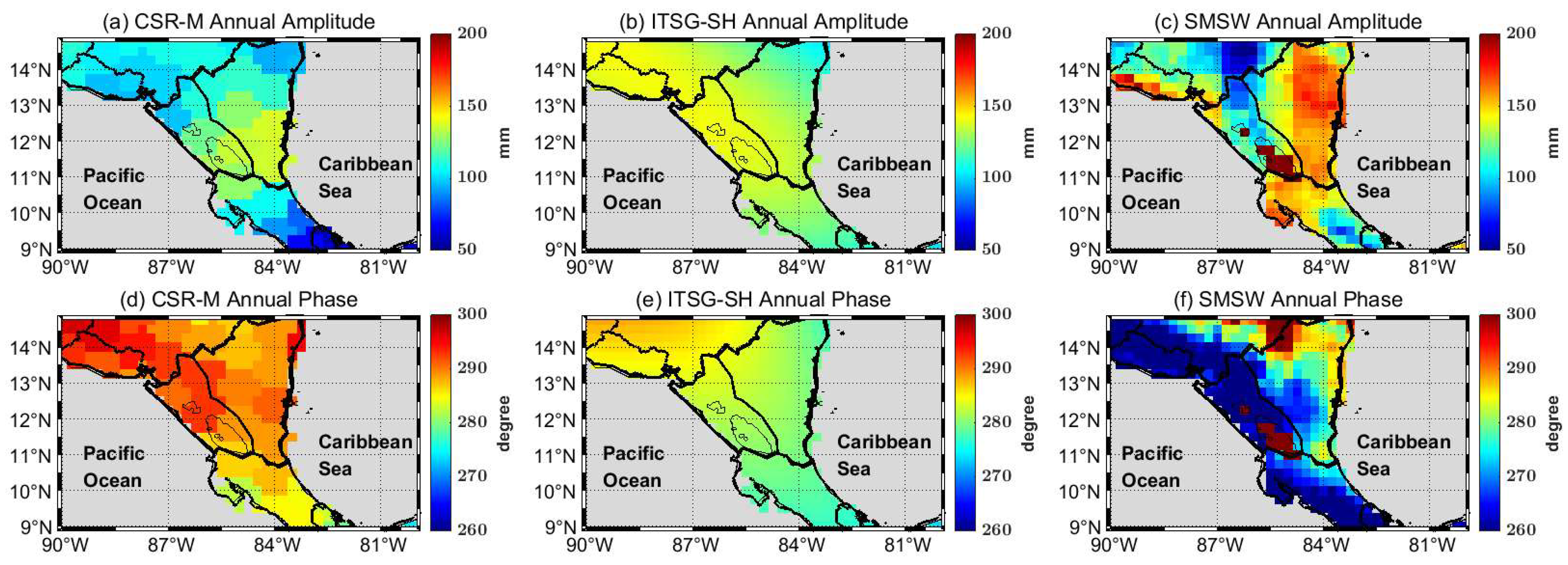

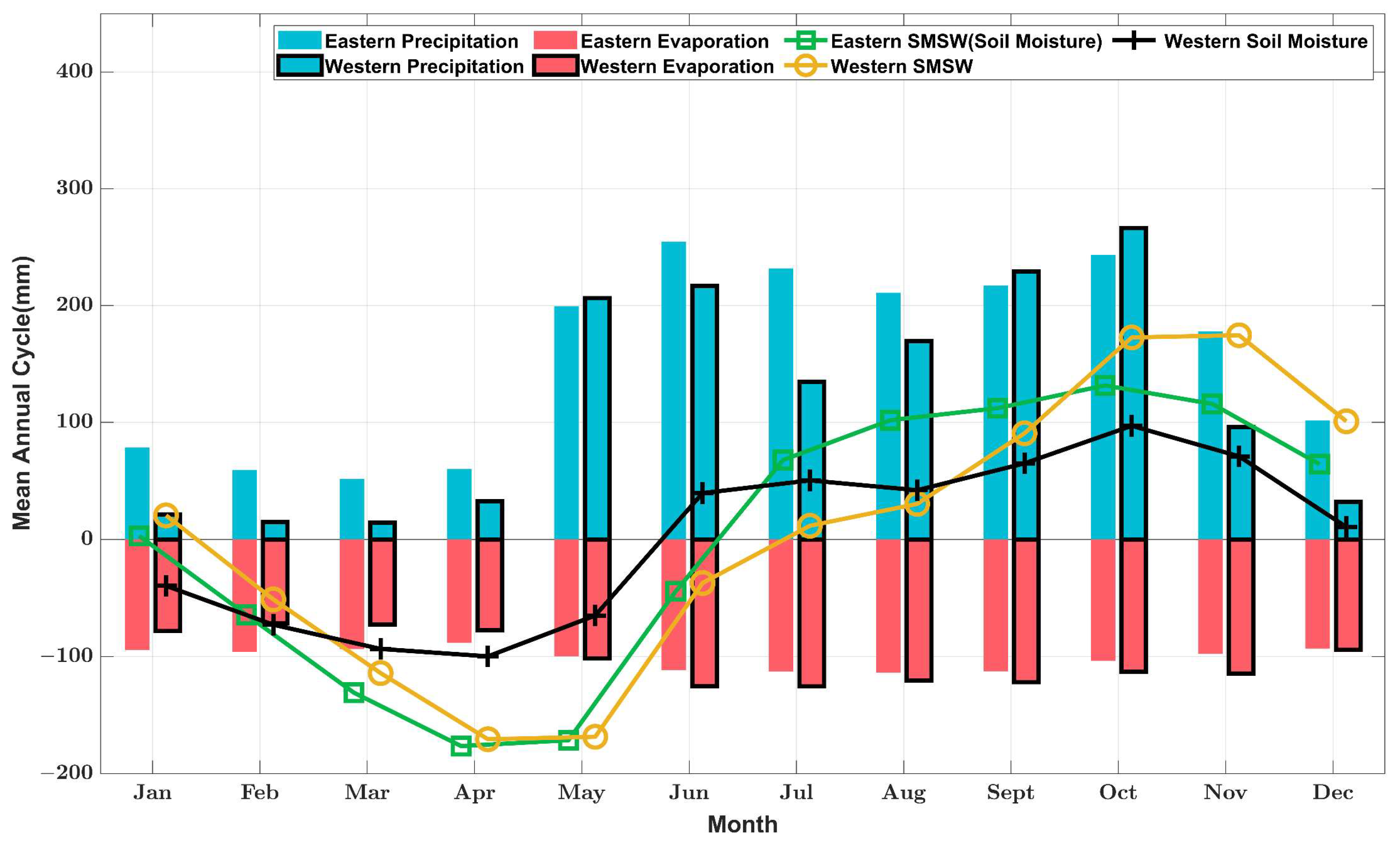

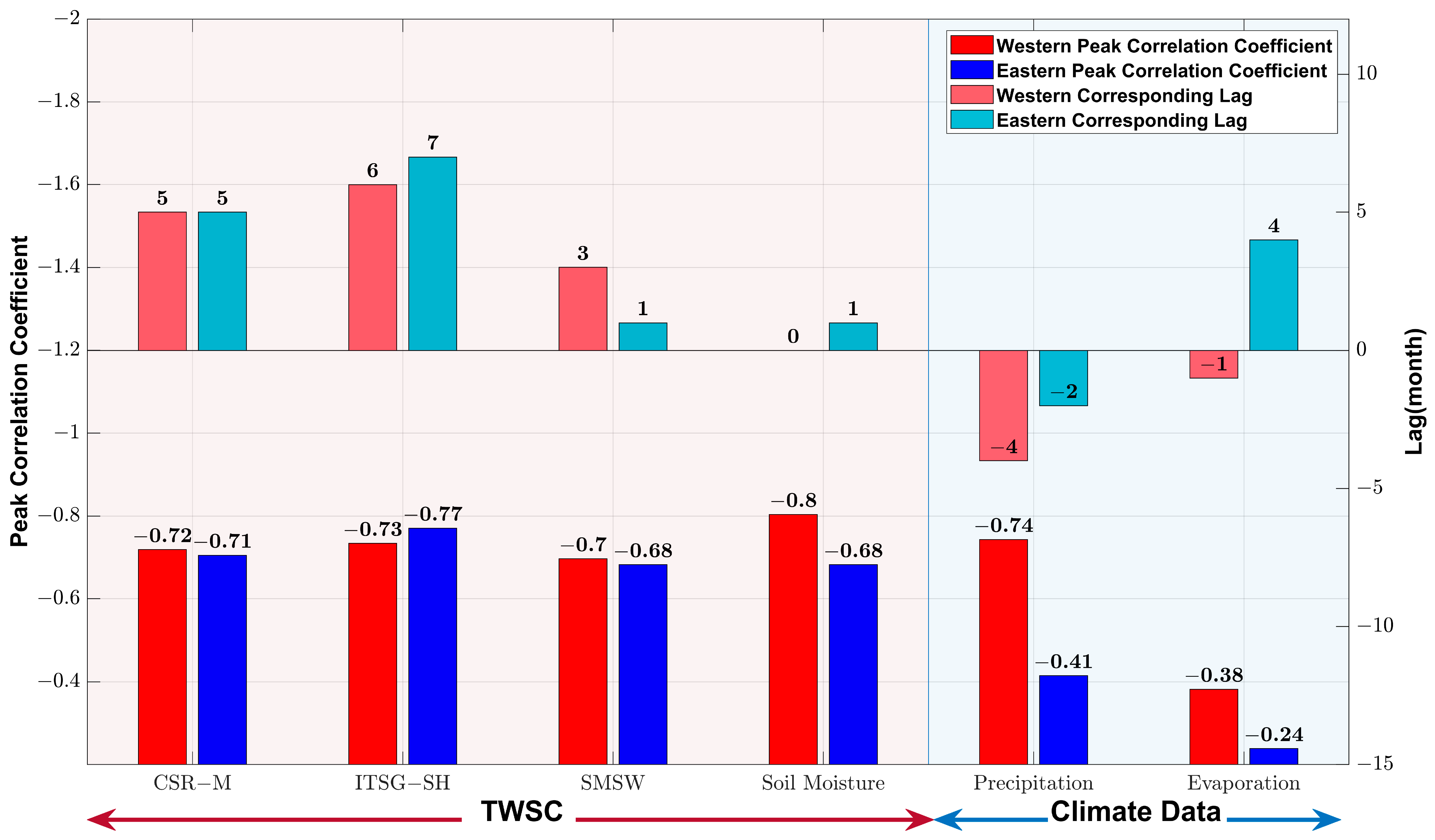
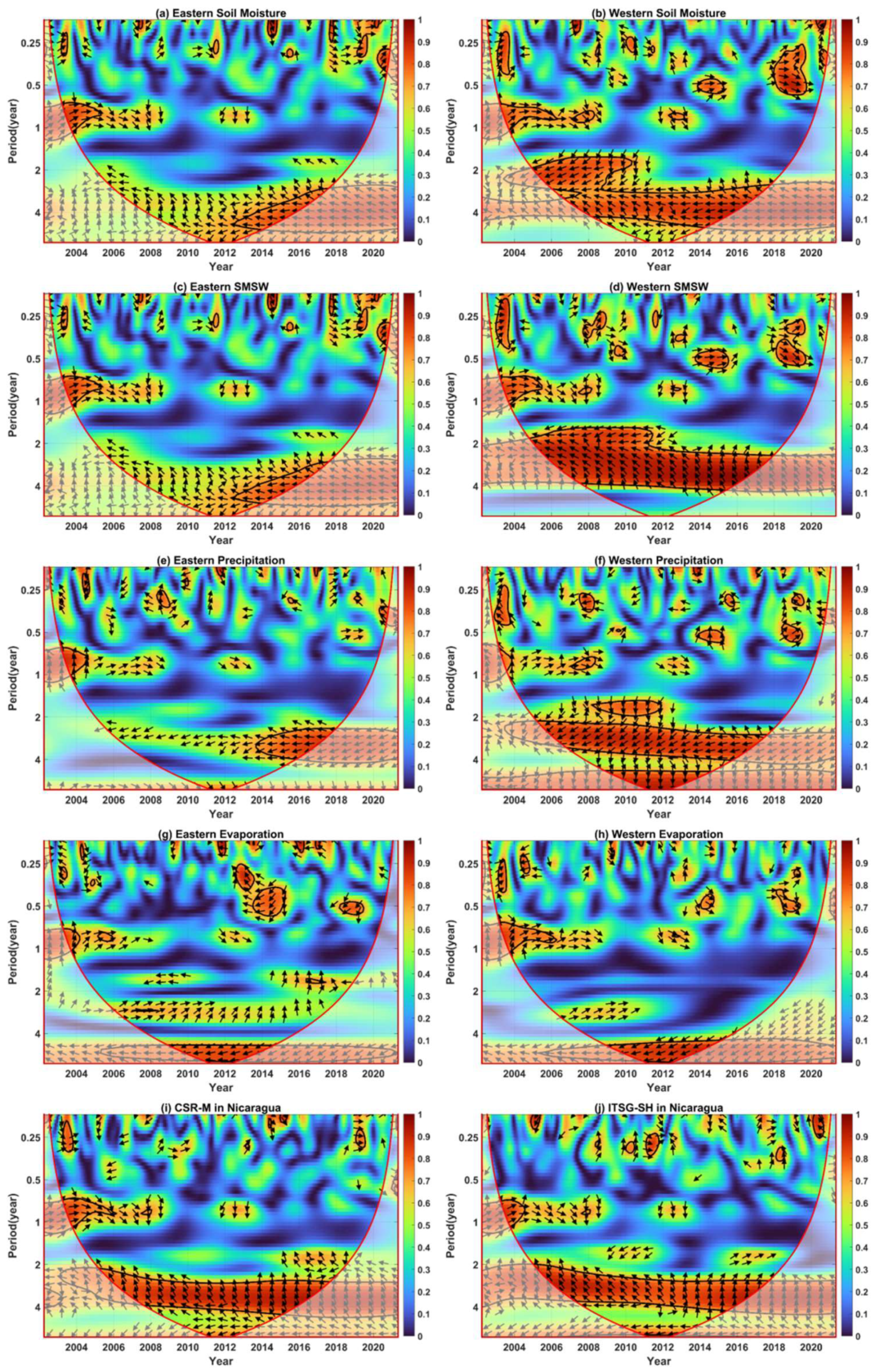
| Sources | Annual Amplitude (mm) | Annual Phase (°) | Linear Trend (mm/a) | |||
|---|---|---|---|---|---|---|
| 2002-04 2021-04 | 2002-04 2012-03 | 2012-04 2017-03 | 2017-04 2021-04 | |||
| ITSG-SH | 130.48 | 280.94 | −3.67 | 8.76 | −44.56 | −32.32 |
| CSR-M | 112.27 | 290.34 | 0.19 | 6.13 | −12.82 | −6.57 |
| SMSW | 152.04 | 283.10 | −2.62 | 2.93 | −15.39 | −15.56 |
Publisher’s Note: MDPI stays neutral with regard to jurisdictional claims in published maps and institutional affiliations. |
© 2022 by the authors. Licensee MDPI, Basel, Switzerland. This article is an open access article distributed under the terms and conditions of the Creative Commons Attribution (CC BY) license (https://creativecommons.org/licenses/by/4.0/).
Share and Cite
Jian, G.; Xu, C.; Li, J.; Zhang, X.; Feng, L. Terrestrial Water Storage Component Changes Derived from Multisource Data and Their Responses to ENSO in Nicaragua. Remote Sens. 2022, 14, 6012. https://doi.org/10.3390/rs14236012
Jian G, Xu C, Li J, Zhang X, Feng L. Terrestrial Water Storage Component Changes Derived from Multisource Data and Their Responses to ENSO in Nicaragua. Remote Sensing. 2022; 14(23):6012. https://doi.org/10.3390/rs14236012
Chicago/Turabian StyleJian, Guangyu, Chuang Xu, Jinbo Li, Xingfu Zhang, and Li Feng. 2022. "Terrestrial Water Storage Component Changes Derived from Multisource Data and Their Responses to ENSO in Nicaragua" Remote Sensing 14, no. 23: 6012. https://doi.org/10.3390/rs14236012
APA StyleJian, G., Xu, C., Li, J., Zhang, X., & Feng, L. (2022). Terrestrial Water Storage Component Changes Derived from Multisource Data and Their Responses to ENSO in Nicaragua. Remote Sensing, 14(23), 6012. https://doi.org/10.3390/rs14236012






